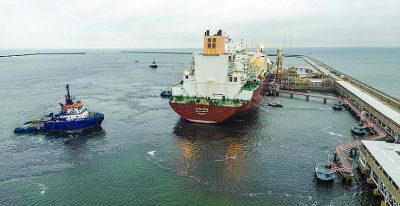Six Megaprojects Are Poised to Turn Poland Into a Regional Economic Powerhouse

All Global Research articles can be read in 51 languages by activating the “Translate Website” drop down menu on the top banner of our home page (Desktop version).
***
Poland is poised to become a regional economic powerhouse upon the successful completion of six megaprojects: the Baltic Ring rail corridor, Świnoujście deepwater port, Vistula Spit Canal, E40 waterway, Central Communication Port, and Via Carpathia highway network.
Poland’s Six Megaprojects
Poland already enjoys the proud distinction of being the largest economy among the post-communist EU-member states, but it’s poised to become an even more pivotal regional powerhouse upon the successful completion of six megaprojects. These are the
- Baltic Ring rail corridor,
- Świnoujście deepwater port,
- Vistula Spit Canal,
- E40 waterway,
- Central Communication Port, and
- Via Carpathia highway network.
Altogether, they aim to enhance Poland’s transregional connectivity potential as the leader of the “Three Seas Initiative” (3SI), an economic bloc of states that it co-founded together with Croatia in 2015.
The “Three Seas Initiative”
The 3SI’s purpose is to comprehensively improve linkages between the Adriatic, Baltic, and Black Seas. It’s American-backed but could also function as a means of facilitating China’s Belt & Road Initiative (BRI) access into EU via the Beijing-owned Greek port of Piraeus, which the East Asian country wants to turn into the biggest in the bloc. The 3SI is an enormous undertaking that might very well take many years to bear fruit, but it’s still arguably among the main grand strategic ambitions of the Third Polish Republic. Its success is dependent on the completion of the six earlier identified megaprojects, which will now be concisely summarized.
Baltic Ring
The Baltic Ring rail corridor envisions circling its eponymous sea by bringing together Poland, the Baltic Republics, Finland, Sweden, Denmark, and Germany. It would represent the modern-day manifestation of the Medieval Hanseatic League trade bloc. The Mediterranean will always remain the most important body of water in the EU, but the Baltic could quickly become the next most significant one from an economic perspective if these plans come to fruition. Taken to its maximum extent, it could even help create a new center of geopolitical gravity in the bloc.
Świnoujście Deepwater Port
As for the Świnoujście deepwater port, it’s expected to complement the Baltic Ring by enabling the Scandinavian countries and also those in the Western Hemisphere like the US and Brazil to directly connect their freight containers with Poland’s rail network, thus easing transshipment between their regions and the Central & Eastern European (CEE) space. With Poland as the centerpiece of this transregional route, it’s well-placed to handsomely profit as the CEE becomes more important for global trade and investment. It’s noteworthy to mention that Świnoujście also hosts a recently constructed LNG terminal too.
Vistula Spit Canal & “Viking Silk Road”
Moving eastward along Poland’s Baltic coast, its Vistula Spit Canal project will enable the country’s economic partners to directly access the Vistula Bay without having to pass through Russia‘s Baltiysk. This is significant since it improves the viability of its E40 waterway (also known as the “Viking Silk Road”) plans to pioneer a riparian corridor through Belarus and Ukraine en route to the Black Sea. The latter project has some serious environmental concerns, however, because it passes through the Chernobyl exclusion zone. This is the riskiest of all six of Poland’s 3SI megaprojects, but perhaps the most geopolitically exciting if Warsaw can pull it off.
Central Communication Port
Reorienting more towards the center of the country, the Central Communication Port (also called the Hub by some) was recently included alongside the Vistula Spit Canal as an important part of Poland’s National Recovery Plan. The Hub envisions the creation of an integrated air, rail, and road junction to serve as the one of the CEE region’s main connectivity points. It’s absolutely indispensable for actualizing Poland’s 3SI vision, which is why it’s being prioritized. This project will also integrate all parts of the domestic economic more closely, further improving Poland’s attractiveness vis-a-vis its regional peers.
Via Carpathia
Finally, the last of the six megaprojects is the Via Carpathia highway network which intends to connect Poland to the Eastern Balkans. In practice, its pairing with the Baltic Ring will enable the creation of an Arctic-Mediterranean Corridor, which perfectly complements China’s BRI plans. It’ll also result in Poland becoming a leading economic player in this comparatively destitute corner of the continent. Over time, the cumulative influence that the country acquires there could help position the 3SI as a more confident political player in the event that its members more closely integrate with one another in all respects.
Concluding Thoughts
In view of the six examined megaprojects, there are plenty of reasons to be optimistic about Poland’s economic future.
The country is rapidly rising to the fore of European transregional connectivity processes, which makes it triply attractive for the EU, US, and China. With economic weight comes political influence, so it’s taken for granted that Warsaw will attempt to wield more power within the highly strategic 3SI space. It remains to be seen what the strategic impact of this will be, but one can only hope that it’ll increase stability in this part of Western Eurasia and not provoke geopolitical competition with other players such as Russia.
*
Note to readers: please click the share buttons above or below. Forward this article to your email lists. Crosspost on your blog site, internet forums. etc.
This article was originally published on OneWorld.
Andrew Korybko is an American Moscow-based political analyst specializing in the relationship between the US strategy in Afro-Eurasia, China’s One Belt One Road global vision of New Silk Road connectivity, and Hybrid Warfare. He is a frequent contributor to Global Research.

